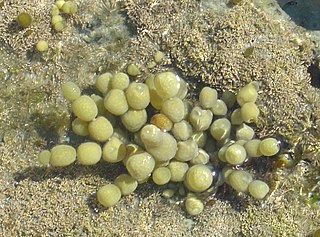
Hormosira banksii, also known as Neptune's necklace, Neptune's pearls, sea grapes, or bubbleweed) is a species of seaweed native to Australia and New Zealand. It is abundant on low-energy rocky reefs at midtide levels, where it outcompetes other algal species due to its high tolerance to desiccation. This is because it has a slimy layer that conserves moisture. The thallus of this species is made up of strings of olive-brown, spherical, gas-filled pneumatocysts, which taper towards a small holdfast that is easily dislodged from the substrate. The spheres rise to the surface of the water during high tide, obtaining more sunlight and moving with the flow of the current.

Fucus is a genus of brown algae found in the intertidal zones of rocky seashores almost throughout the world.

Fucus serratus is a seaweed of the north Atlantic Ocean, known as toothed wrack or serrated wrack.
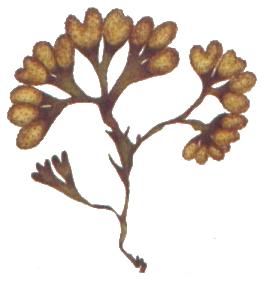
Fucus spiralis is a species of seaweed, a brown alga, living on the littoral shore of the Atlantic coasts of Europe and North America. It has the common names of spiral wrack and flat wrack.

Padina pavonica, commonly known as the peacock's tail, is a small brown alga found in the Indian Ocean, the Pacific Ocean, the Atlantic Ocean and the Mediterranean Sea. It inhabits pools in the littoral zone typically with clayey, silty or sandy sediments. Other habitats include rocks and shell fragments in the shallow sublittoral, seagrass meadows, mangrove roots and coral reefs on tidal flats
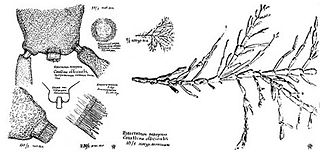
Corallina officinalis is a calcareous red seaweed which grows in the lower and mid-littoral zones on rocky shores.

Macrocystis pyrifera, commonly known as giant kelp or giant bladder kelp, is a species of kelp, and one of four species in the genus Macrocystis. Despite its appearance, it is not a plant; it is a heterokont. Giant kelp is common along the coast of the western Pacific Ocean, from Baja California north to southeast Alaska, and is also found in the southern oceans near South America, South Africa, Australia, and New Zealand. Individual algae may grow to more than 45 metres long at a rate of as much as 60 cm (2 ft) per day. Giant kelp grows in dense stands known as kelp forests, which are home to many marine animals that depend on the algae for food or shelter. The primary commercial product obtained from giant kelp is alginate, but humans also harvest this species on a limited basis for use directly as food, as it is rich in iodine, potassium, and other minerals. It can be used in cooking in many of the ways other sea vegetables are used, and particularly serves to add flavor to bean dishes.

Coastal fish, also called inshore fish or neritic fish, inhabit the sea between the shoreline and the edge of the continental shelf. Since the continental shelf is usually less than 200 metres deep, it follows that pelagic coastal fish are generally epipelagic fish, inhabiting the sunlit epipelagic zone. Coastal fish can be contrasted with oceanic fish or offshore fish, which inhabit the deep seas beyond the continental shelves.
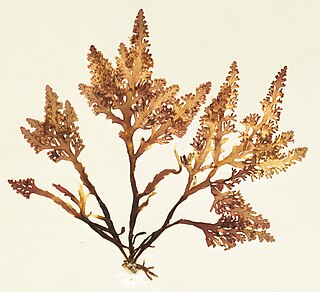
Osmundea pinnatifida is a species of red alga known by the common name pepper dulse.

Fucus distichus or rockweed is a species of brown alga in the family Fucaceae to be found in the intertidal zones of rocky seashores in the Northern Hemisphere, mostly in rock pools.

Ahnfeltia plicata, the landlady's wig, is a species of red alga in the family Ahnfeltiaceae. It grows in northern parts of the Atlantic Ocean.
Lobophora variegata is a species of small thalloid brown alga which grows intertidally or in shallow water in tropical and warm temperate seas. It has three basic forms, being sometimes ruffled, sometimes reclining and sometimes encrusting, and each form is typically found in a different habitat. This seaweed occurs worldwide. It is the type species of the genus Lobophora, the type locality being the Antilles in the West Indies.
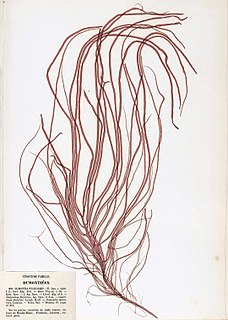
Dumontia contorta is a relatively small epiphytic algae of the sea-shore.

Phycodrys rubens is a red marine alga of up to 30 cm long.
Phyllophora sicula, the hand leaf bearer, is a small red marine alga.
Osmundea hybrida is a fairly small marine red alga.

Polyides rotunda is a species of small red marine alga in the family Polyidaceae.
Catenella caespitosa is a small red marine alga.
Gastroclonium reflexum is a small red marine seaweed.
Chylocladia verticillata is a medium-sized red marine alga.













